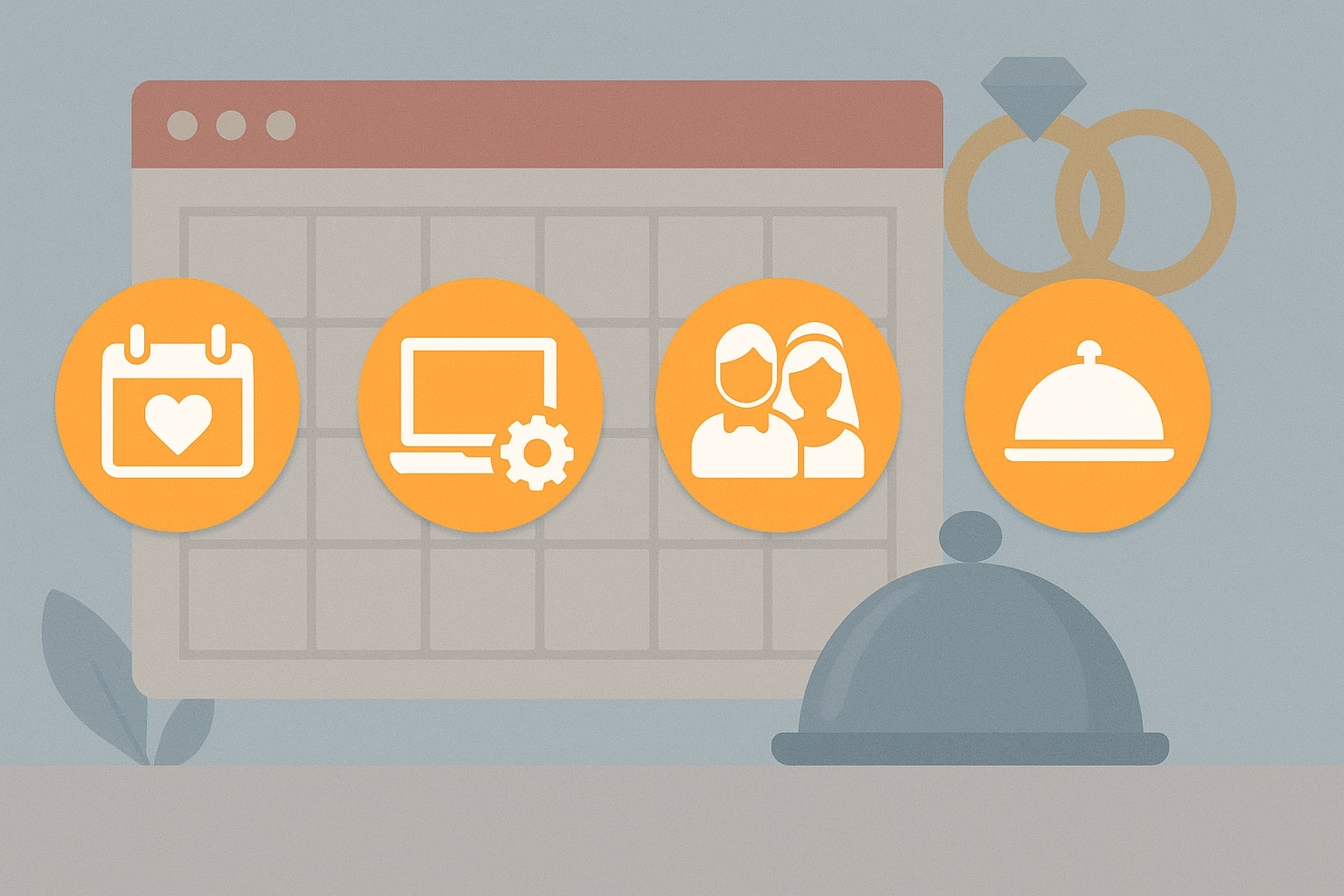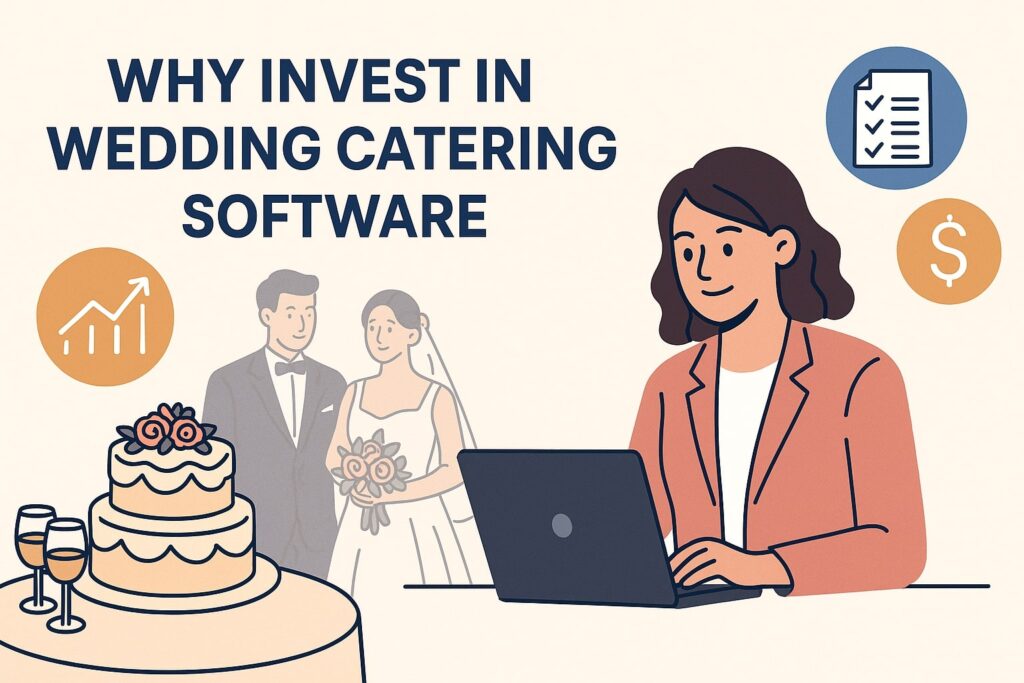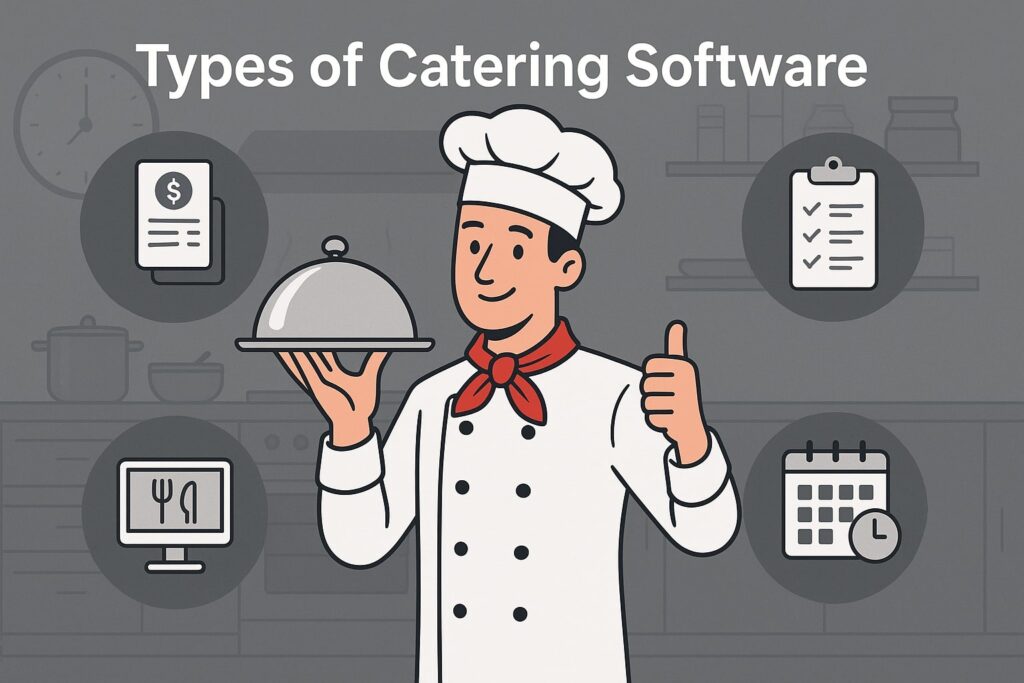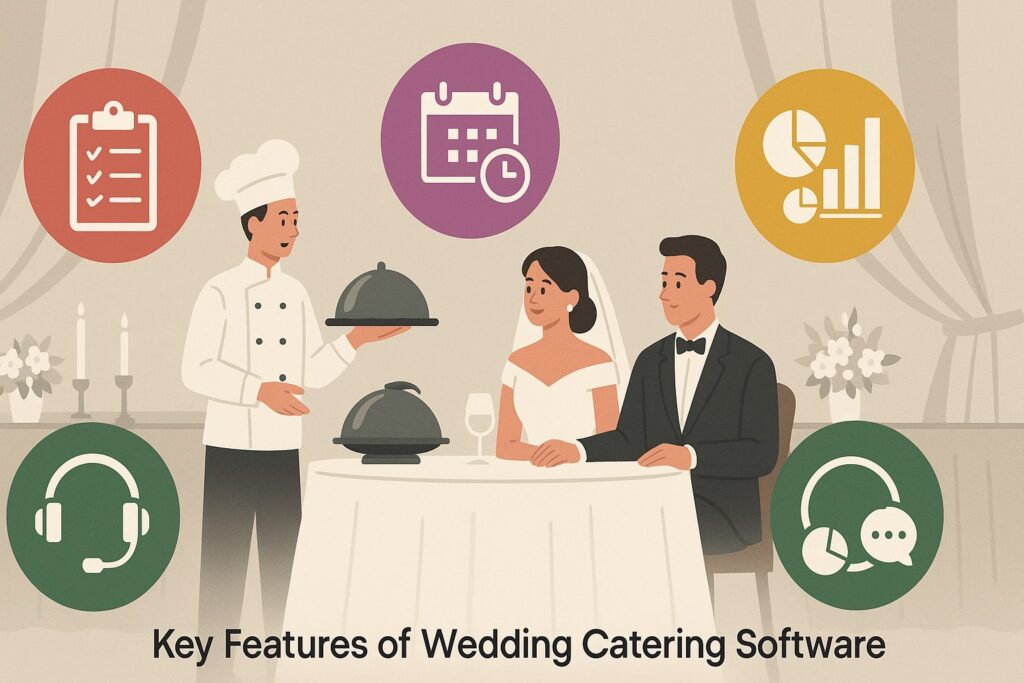
By cloudcateringmanager September 22, 2025
Managing a wedding’s catering can be a monumental task. Modern wedding catering software streamlines these complexities by centralizing menus, guest lists, staff schedules, and finances into one platform.
In fact, according to industry research, catering software solutions are specifically designed to handle event planning, menu design, order tracking, invoicing, CRM, inventory control and more.
The U.S. catering market is huge (about $60.4 billion in 2022) and growing rapidly, so using the right digital tools is crucial. Whether you’re a wedding planner, venue manager or caterer, understanding the must-have features of catering software will help you choose a solution that keeps weddings on track and budgets in check.
In practice, wedding catering software acts like a digital banquet event order (BEO) system and kitchen assistant combined. It should let you create customized menu plans (including dietary restrictions), send professional proposals, manage client communications, schedule staff, and track expenses all in one place.
Many platforms are cloud-based or offer mobile apps (web, iOS, Android) so you can access details from the office or the event site. In this guide, we’ll cover the key functionalities to look for, typical pricing models, integration options, and examples of popular software used by U.S. wedding caterers.
Why Invest in Wedding Catering Software?

Even small wedding caterers juggle dozens of tasks: designing menus, coordinating with florists and DJs, ordering food, invoicing clients, and managing staff. Doing this on spreadsheets or paper invites errors and missed details.
Modern catering software automates many of these processes. It provides a centralized dashboard so you can see all upcoming events, orders, and tasks at a glance.
For example, instead of manually copying menus into invoices, a catering app can auto-generate quotes and convert them to orders with one click. Automatic reminders and alerts keep the team on schedule.
As one industry article notes, automating bookings and payments “reduces errors and speeds up processes,” letting staff focus on service quality. In short, good catering software helps deliver flawless weddings by reducing manual work and improving communication.
Types of Catering Software

Catering systems come in various forms. Cloud-based (web) software is now very common – it runs in your browser and often on a subscription basis. The benefit is no complex setup: updates and backups are automatic, and you can log in from any internet-connected device.
For on-site use, many vendors also offer mobile apps for iPhone/Android so staff can check orders, clock hours, or view floor plans on tablets. Some companies still offer on-premises or desktop software (installed on local servers), but these are less common for small catering teams.
For example, the popular platform Connecteam provides web access plus iOS and Android apps. This means managers can create schedules on a PC, while on-site workers use the mobile app to clock in and chat.
Other solutions (like Tripleseat or Total Party Planner) are primarily cloud/web-based, sometimes with optional desktop modules. In any case, a modern wedding catering solution should support multi-platform use so your planners, chefs and servers can use the device that fits their role.
Key Features of Wedding Catering Software

When evaluating catering software, look for modules and tools in the following areas. The most powerful solutions bundle all these functions into one package:
- Event and Booking Management: A good system includes a calendar or event scheduler to manage wedding dates and avoid double-booking. You should be able to create events for each wedding, add details like date/time, venue and headcount, and link client contacts.
Many platforms let you manage guest lists and seating alongside menus – useful for weddings to track RSVPs and dietary needs. Advanced features might include banquet event order (BEO) templates or floor-plan designers.
For example, Paytronix notes that a wedding caterer can use an event management tool to stay organized, managing guest lists, timelines and vendor relationships all in one place. Automated reminders (e.g. payment due dates or tasting appointments) are often built in to keep every step on track. - Menu and Recipe Management: Wedding menus can be complex (multi-course dinners, cocktails, dessert bars). The software should let you create and edit menu templates easily.
This includes adding menu items, descriptions, pricing and images if needed. Recipe and ingredient tracking is a big plus: the system should calculate food costs based on recipes and guest count, and adjust ingredient quantities automatically.
Real-time inventory tracking is ideal – it alerts you to low-stock ingredients and can even generate purchase orders to suppliers. For instance, Total Party Planner highlights that its software offers “real-time inventory tracking, allowing caterers to monitor their supplies and ingredients accurately”.
In practice, this means if a wedding requires 200 servings of chicken salad, the software deducts those ingredients from inventory and warns you if you’re below par. This prevents last-minute shortages or waste. - Customer and Order Management (CRM): A built-in CRM module or client database is essential. You should be able to store each wedding client’s contact info, event details and order history in one profile.
This makes it easy to retrieve data for future events (e.g. anniversary parties). Order management tools let you create quotes or proposals and convert them into confirmed orders.
Many systems allow attaching contracts and capturing electronic signatures online. Automatic communication tools (email/SMS) ensure everyone is informed – for example, some platforms automatically email the client when an invoice is generated or when final guest counts are due.
As Paytronix points out, catering software often has order management and client data handling to build strong customer relationships.
Tripleseat’s platform, for instance, emphasizes features like customizable proposals, online payments, and automated client notifications to “streamline bookings and sales for both clients and employees”. - Staff Scheduling and Task Management: Coordinating chefs, servers, bartenders and cleanup crews is critical for a wedding. Top catering software includes shift scheduling, letting you assign staff roles to specific events via drag-and-drop calendars.
You can send each worker their schedule (often via mobile app notification). Integrated time clocks (even with geofencing) ensure staff can only clock in at the venue.
For example, Connecteam’s all-in-one platform offers geofence time clocks and selfie check-in features to prevent time fraud during events.
Additionally, look for a task/checklist module: the ability to create event-specific to-do lists (set up tables, pack equipment, follow up on payments, etc.) and assign them to individuals.
You can then track task completion. Connecteam, for example, highlights the ability to create both one-time and recurring tasks and monitor their status to keep events on schedule. - Billing, Invoicing and Payments: The software should streamline the financial workflow. Look for features that automatically generate invoices from orders, apply taxes and discounts, and send them to clients electronically.
Integration with payment gateways (like Stripe, Square or PayPal) is very handy so you can collect deposits or full payments online. Automated payment reminders can be configured for late balances.
As noted by Total Party Planner, modern catering platforms “automate invoice generation and integrate payment processing directly into the system” – saving time and improving cash flow.
Likewise, Tripleseat touts secure online payments and PCI-compliance so couples can pay contracts safely through the software. - Reporting and Analytics: Data-driven insights help your business improve. The software should offer reporting tools for key metrics: total revenue, food costs, labor hours, profit margins, and customer satisfaction (if tracked).
You might want dashboards showing upcoming events, top-selling menu items, or budget vs actual spending. According to Total Party Planner, the best systems provide “powerful reporting and analytics tools” to track metrics like revenue, expenses, and customer satisfaction.
Tripleseat similarly emphasizes detailed event-level reports and KPIs to evaluate performance. In practice, robust reporting lets you see which wedding packages are most profitable or adjust pricing based on past data. - Marketing and Loyalty Tools (Optional): Some platforms include marketing modules. These may automate email campaigns or promotions to past wedding clients (for anniversary deals, catering reviews, etc.), and track referrals or repeat bookings.
As Paytronix notes, leading catering software sometimes has built-in loyalty programs or campaign tools to help you retain clients.
Even if not built in, look for integrations with email marketing services (Mailchimp, Constant Contact) so you can export guest lists for newsletters. - Integrations: A flexible catering system will connect with other tools. Accounting software (QuickBooks, Xero) integration lets you export invoices and payroll data seamlessly.
For example, Connecteam integrates with QuickBooks and ADP for payroll. The platform should also sync with digital calendars (Google Calendar, Outlook) so event dates appear on everyone’s schedule.
Integrating with vendor/supplier portals or kitchen display systems can further streamline ordering. If you have a website or booking portal, API or Zapier integrations can automatically create quotes for inquiries.
In general, seamless integration “centralizes data and streamlines workflows” – avoiding duplicate data entry. - Mobile and Cloud Capabilities: As mentioned, mobility is key. Look for solutions that offer real-time mobile access so managers and on-site staff see the latest info. Data should sync across devices instantly.
Cloud-based systems also mean your data is backed up offsite and you can grant access to remote collaborators (e.g. a partner or parent organization). - Security and Compliance: Finally, since wedding catering involves handling customer data and payments, ensure the software uses encryption and meets standards. Payment processing should be PCI-compliant.
There should be user permission controls (e.g. only managers can access financials). Check that data can be exported and backed up.
Pricing and Licensing Models
Catering software pricing varies widely. Subscription plans (monthly/yearly) are common, often tiered by features or number of users/events. Some offer a one-time license fee instead. Here are examples of typical pricing structures:
- Per-Month Subscriptions: Many SaaS catering solutions charge around $50–$300 per month depending on scope.
For instance, CaterZen’s core catering management plan starts at about $179/month and goes up to $229/mo for full features (including online ordering and marketing tools). STS Cloud (a full hotel sales & catering system) starts at $159/month for unlimited users and includes extensive CRM and catering modules. - Affordable/Entry Plans: Some software is budget-friendly for small teams. Connecteam – while primarily an employee management app – offers a dedicated catering plan for only $29/month (covering up to 30 users).
They even provide a free version for very small teams (up to 10 users). Similarly, industry reviews note that Total Party Planner (TPP) has packages beginning around $99/month for its basics. - Per-User or Per-Event Fees: A few systems add fees per additional user or event. For example, Better Cater charges $69 base + $30 for each extra user. Others bundle unlimited users but may restrict events or features by plan.
- Custom Pricing: High-end enterprise solutions or those tailored to large venues (like Caterease or Tripleseat) often require contacting sales for a quote. Caterease, known for banquet booking management, typically quotes based on venue size and needs.
- Free Trials/Demos: Most vendors offer a free trial or demo period so you can test the software without commitment. Take advantage of those to gauge ease of use.
In summary, you can expect to pay anywhere from tens to hundreds of dollars per month. Smaller catering operations may find affordable entry-level plans, while full-featured enterprise systems cost more. Always compare what’s included – unlimited menu items, reports, or integrations – before choosing a plan.
Popular Catering Software Options
Several software products are commonly used for wedding and event catering in the US. Each has its own strengths:
- Total Party Planner (TPP): A comprehensive catering and event planning system. It excels at menu and inventory costing. TPP offers templates for proposals and BEOs, and robust reporting. Entry plans start around $99/month.
- Caterease: A long-standing Windows-based system focused on banquet management and event scheduling. It offers extensive menu-building and floor-plan tools. Caterease usually provides pricing upon request, as it is often customized by venue.
- Connecteam: A versatile workforce management app with catering functionality. It includes employee scheduling, time tracking, task checklists, and communication. Pricing is very low ($29/mo up to 30 users) and even a free plan is available. While not a full kitchen management system, it covers many operational aspects of catering.
- Spoonfed and Flex Catering: These are examples of software focused on restaurants with catering services. They emphasize online ordering, delivery routing, and billing automation.
Spoonfed integrates with Xero/QuickBooks and offers online quoting. Flex Catering provides branded online storefronts and group orders, integrating with Stripe, PayPal, and other tools. Pricing for these is typically quote-based (contact vendor). - CaterZen: An all-in-one catering CRM and management suite. It includes menu creation, online ordering, marketing tools (email campaigns, voip calling), and more.
Plans start at $179/month for the basic package, which already includes features like unlimited menus. Higher tiers add things like delivery management and advanced marketing. - STS Cloud (Sales & Catering): Originally for hotels, STS Cloud offers full sales, catering, and group management. For venues or large event caterers, it provides a single flat rate (starts at $159/mo) with unlimited users and built-in CRM.
- MarketMan: A specialized inventory management solution (often used in catering). It streamlines purchasing and stock. The cloud-based plan is around $199/month.
- Other Notables: Tripleseat is a popular event management tool used by restaurants and hotels (features include lead capture, CRM, online ordering, e-signatures); however, pricing is by quote.
Planning Pod is an all-in-one event planning platform (contact for pricing). Curate is designed for florists but used by some caterers for order management (annual plan about $1250).
When choosing, consider your priorities: if inventory and costing are key, TPP or MarketMan may stand out. If you need strong scheduling and mobile apps, Connecteam could be ideal.
For online client engagement, solutions like Tripleseat or CaterZen (with payment portals) are attractive. Always ask for a demo and compare feature sets and pricing.
Integration Considerations
A major advantage of modern wedding catering software is its ability to integrate with other tools you use. For example, integrating with your accounting software (QuickBooks, Xero) means sales data flows directly into your books.
Software like Connecteam lets you export timesheets to payroll systems such as QuickBooks Online or ADP. Many platforms integrate with email/calendar systems (Google/Outlook) so that booked events appear on everyone’s schedule.
Integrations with point-of-sale (POS) terminals, CRM or marketing platforms (Mailchimp, Salesforce) can further unify your operations. Before committing, check that the vendor supports the specific third-party apps you rely on.
A well-integrated ecosystem saves time by avoiding duplicate data entry and keeps all your team members on the same page.
Frequently Asked Questions (FAQs)
Q: What exactly is wedding catering software?
A: It’s a specialized software platform designed to manage all aspects of catering for weddings and events. It typically includes tools for event scheduling, menu and recipe management, inventory control, client management, invoicing, and reporting. In short, it replaces many spreadsheets and paper forms with a single digital system.
Q: Why should a wedding caterer use dedicated software?
A: Because weddings involve many moving parts, software helps reduce errors and save time. For example, it can automatically adjust ingredient quantities if the guest count changes, send payment reminders, and prevent double-booking venues.
According to experts, modern catering systems streamline operations, optimize client service, and free staff to focus on quality rather than paperwork.
Q: What are the most important features to look for?
A: At minimum, look for event/booking management (digital calendar), menu/recipe costing, customer database (CRM), invoicing/payment processing, and reporting. You’ll also benefit from staff scheduling, task checklists, and mobile access.
If you do a lot of large events, integrated banquet order (BEO) forms and floor plans may be essential. Advanced features like online client portals, loyalty programs, or marketing tools are nice-to-haves for growing businesses.
Q: How much does catering software cost?
A: It varies widely. Basic plans can be under $100/month (e.g. Total Party Planner’s basic tier ~$99) while full-featured enterprise solutions can be $200+/month (e.g. CaterZen around $179–$229). Some charge per user or per event.
Many offer a free trial. Remember to factor in that a slightly higher monthly fee can be worth it if it eliminates manual errors and saves staff hours.
Q: Should I choose cloud-based or desktop software?
A: For most wedding caterers, cloud-based (SaaS) solutions are recommended. They offer automatic updates and access from anywhere (office, home, event site) with an internet connection.
Desktop software can work offline but lacks flexibility. If you have reliable internet and want easy collaboration, go cloud. If you prefer one-time purchase and full data control, some providers still offer desktop licenses.
Q: Can small catering teams use these systems? Are there free options?
A: Yes. Some vendors offer entry-level plans or even free tiers. For instance, Connecteam’s catering package is just $29/month for up to 30 users, and completely free for teams up to 10 users.
Other companies sometimes have starter packages (or non-profit rates). For a very small operation, look for low-cost plans or providers with “lite” versions. A free trial is a great way to test usability before paying anything.
Q: How do I choose the right software for my wedding catering business?
A: Start by listing your must-have features (e.g. inventory tracking, mobile scheduling, online bookings) and your budget. Then compare software demos or reviews focusing on those needs.
Pay attention to ease of use and customer support, not just features. According to experts, the best choice balances functionality, user-friendliness, and cost for your specific situation. Check online reviews and ask peers which systems they use.
Since the investment can be significant, take advantage of trial periods or pilot programs to ensure a good fit.
Conclusion
Wedding catering software can be a game-changer for event professionals, automating tedious tasks and ensuring no detail is overlooked. The must-have features we’ve outlined – from event scheduling and menu costing to mobile access and integrated billing – are the foundation of any effective catering platform.
By choosing software that covers these needs, wedding caterers and planners can focus more on creating memorable experiences for their clients and less on paperwork.
When evaluating solutions, remember to consider pricing, scalability, and how well the software integrates with your existing tools. Ultimately, the right catering management software will save time, reduce errors, and help grow your business – a true recipe for success in the competitive wedding industry.